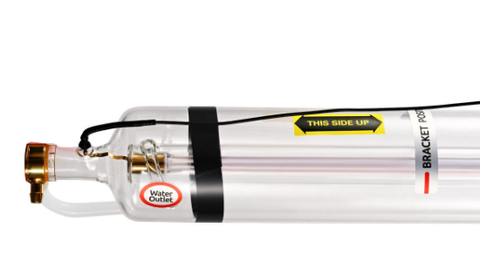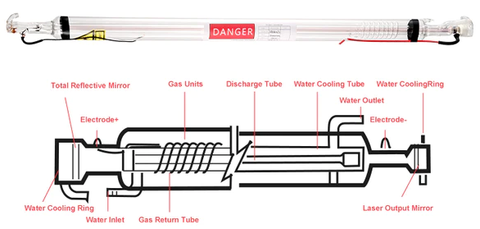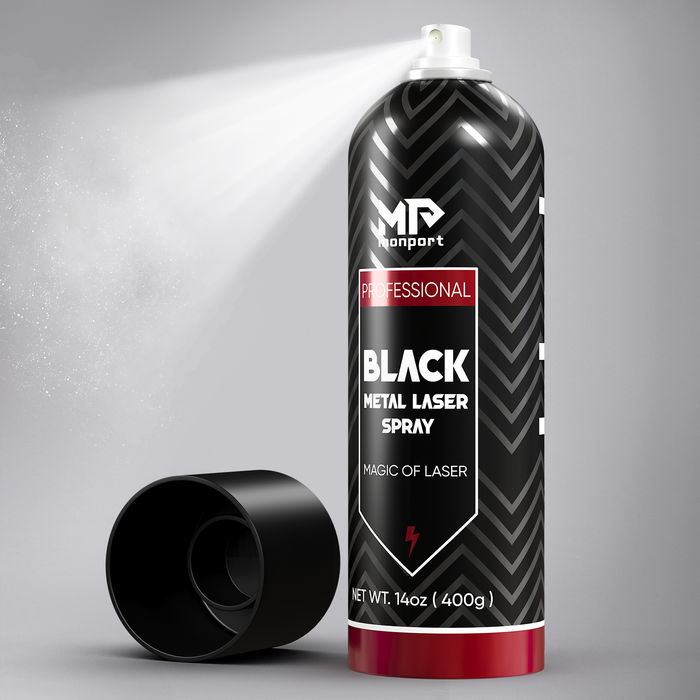You understand how crucial it is to address any issues that might arise because your company specializes in laser tube and CO2 laser tube engraving. In this blog post, we'll talk about some of the most typical laser tube issues and offer solutions. This information will enable you to get the most out of your engraving tools, regardless of how experienced you are with lasers or whether you are just getting started. Continue reading to discover how to handle laser engraving issues like a pro.
Monport 40W Pro Lightburn-Supported (12" X 8") CO2 Laser Engraver & Cutter with Air Assist
BEST DEAL ALERT: Want to save on your next purchase? Use code BESTMP10 at checkout – click here to shop now!
The Laser Tube Head fell off

If the laser tube head has fallen off, it is important to determine if there is any damage to the laser tube itself or to the mounting hardware. If there is damage, it may be necessary to replace the laser tube or the mounting hardware. If the laser tube and mounting hardware are undamaged, you may be able to reattach the laser tube head by carefully aligning the mounting hardware and securing it in place. It is important to follow the manufacturer's instructions for attaching the laser tube head, as improper alignment or mounting can result in damage to the laser system or injury to the operator. If you are unsure how to properly attach the laser tube head or if there is any damage to the CO2 laser tube or mounting hardware, it is best to consult a laser tube maintenance professional or the manufacturer for assistance.
The laser tube is cracked or broken
If your CO2 laser tube is leaking water into the outer chamber, it is important to shut off the laser tube system and disconnect the power supply to prevent any electrical hazards. You should also use caution when handling the laser tube, as broken glass or other debris can cause injury.
To replace the laser tube, you will need to follow the manufacturer's instructions for removing and installing a new laser tube. This may involve removing the laser tube head and carefully aligning the new laser tube in the mount. It is important to handle the laser tube carefully and to ensure that it is properly aligned and secured in the mount to prevent damage to the laser system or injury to the operator. If you are unsure how to replace the laser tube or if there is any other damage to the laser system, it is best to consult a laser maintenance professional or the manufacturer for assistance.
The laser tube is leaking water into the outer chamber
If your laser tube is leaking water into the outer chamber, it is important to shut off the laser system and disconnect the power supply to prevent any electrical hazards. You should also use caution when handling the laser tube, as the water may be hot or may contain chemicals that could be hazardous to your health.
There are a few possible causes for a laser tube to leak water into the outer chamber:
- The cooling system may be malfunctioning or may have a leak.
- The seals around the laser tube may be damaged or worn, allowing water to escape.
- There may be a problem with the water supply or filtration system.
To troubleshoot the problem, you will need to check the cooling system, seals, and water supply to identify the root cause of the leak. It may also be necessary to consult the manufacturer or a laser tube maintenance professional to diagnose and fix the problem.
In the meantime, you should carefully clean up any water that has leaked into the outer chamber to prevent damage to the CO2 laser tube system or injury to the operator.
The laser tube wire(s) is burnt, fried, or discolored
If the wire(s) on your laser tube are burnt, fried, or discolored, this could indicate a problem with the power supply or the laser tube itself. It is important to shut off the laser system and disconnect the power supply to prevent any electrical hazards. You should also use caution when handling the laser tube and wire(s), as they may be hot or may contain hazardous materials.
There are a few possible causes for burnt, fried, or discolored wires on a laser tube:
- The power supply may be malfunctioning or may be providing too much power to the laser tube.
- The laser tube may be damaged or may be experiencing an electrical issue.
- The wire(s) themselves may be damaged or may not be properly insulated.
To troubleshoot the problem, you will need to check the cooling system, seals, and water chiller to identify the root cause of the leak. It may also be necessary to consult the manufacturer or a laser maintenance professional to diagnose and fix the problem.
If the wire(s) are damaged, they will need to be repaired or replaced to ensure the safe operation of the laser system. It is important to follow the manufacturer's instructions for repairing or replacing the wire(s) to prevent injury or damage to the laser system.
The laser tube is intact , appears undamaged, but does not fire
If your CO2 laser tube is intact and appears to be undamaged, but does not fire, there could be a problem with the power supply, the laser tube system controller, or the laser tube itself. It is important to shut off the laser system and disconnect the power supply to prevent any electrical hazards.
There are a few steps you can take to troubleshoot this problem:
- Check the power supply: Make sure the power supply is properly connected and functioning correctly. You may need to test the power supply or consult the manufacturer or a laser maintenance professional to diagnose any issues.
- Check the laser system controller: Make sure the controller is properly connected and functioning correctly. You may need to test the controller or consult the manufacturer or a laser maintenance professional to diagnose any issues.
- Check the laser tube: Make sure the laser tube is properly aligned and secured in the mount. You may need to test the laser tube or consult the manufacturer or a laser maintenance professional to diagnose any issues.
If you are unable to determine the root cause of the problem, it is best to consult the manufacturer or a laser maintenance professional for assistance.
The laser tube out of the light is very weak
If the laser tube is producing a weak laser beam, it could be due to a few different factors. Some possible explanations include:
The laser tube is not receiving enough power: Laser tubes require a specific amount of electrical current to function properly. If the laser tube is not receiving enough power, it may produce a weak laser beam.
The laser tube is damaged: If the laser tube has been damaged in some way, it may produce a weak laser beam. This could be due to physical damage to the tube, or it could be due to a manufacturing defect.
The laser tube is not properly aligned: Laser tubes need to be properly aligned in order to function properly. If the laser tube is not aligned correctly, it may produce a weak laser beam.
The laser tube is not being controlled properly: Laser tubes require specific signals in order to function properly. If the laser tube is not receiving the correct signals, it may produce a weak laser beam.
It's worth noting that there could be other reasons why a laser tube might produce a weak laser beam. If you are experiencing this issue, it may be helpful to consult with a specialist or the manufacturer of the laser tube to determine the cause of the problem.
The laser tube does not emit laser
There are a few potential reasons why a laser tube may not emit laser. Some possible explanations include:
The laser tube is not receiving enough power: Laser tubes require a specific amount of electrical current to function properly. If the laser tube is not receiving enough power, it may not be able to emit laser.
The laser tube is damaged: If the laser tube has been damaged in some way, it may not be able to emit laser. This could be due to physical damage to the tube, or it could be due to a manufacturing defect.
The laser tube is not properly aligned: Laser tubes need to be properly aligned in order to function properly. If the laser tube is not aligned correctly, it may not be able to emit laser.
The laser tube is not being controlled properly: Laser tubes require specific signals in order to function properly. If the laser tube is not receiving the correct signals, it may not be able to emit laser.
It's worth noting that there could be other reasons why a laser tube may not emit laser. If you are experiencing this issue, it may be helpful to consult with a specialist or the manufacturer of the laser tube to determine the cause of the problem.
How to avoid problems with a laser tube
Here are a few more specific suggestions for avoiding problems with a laser tube:

Follow the manufacturer's instructions: Be sure to read and follow the manufacturer's instructions for using the laser tube. These instructions will provide guidance on how to use the laser tube safely and effectively.
Avoid rough handling: Be careful when handling the laser tube, as rough handling or accidental damage could cause problems with the laser tube.
Keep the laser tube clean: Use a clean, dry cloth to wipe down the laser tube on a regular basis, and be sure to remove any debris or contaminants that may be present.
Perform regular maintenance: Follow the manufacturer's recommendations for regular maintenance of the laser tube, such as cleaning and aligning the laser tube. This will help to ensure that the laser tube is operating at its best.
Use the correct power supply: Use the correct power supply for the laser tube, as using a power supply with the wrong voltage or amperage could cause problems with the laser tube.
Additionally, a well-maintained water chiller can prevent overheating issues and ensure that the laser tube is operating within optimal temperature ranges, which helps prolong its life.
By following these steps, you can help to ensure that your laser tube operates smoothly and consistently. If you have any specific questions about how to avoid problems with a laser tube, don't hesitate to ask!
Other problems of laser tube
Many other problems may occur with the laser tube, including:
- Low laser power output: This could be caused by a faulty power supply, a damaged laser tube, or issues with the water chiller.
- Poor beam quality: This could be caused by a misaligned resonator, contamination on the optics, or a faulty laser tube.
- High noise levels: This could be caused by a faulty laser tube, a problem with the water chiller, or issues with the power supply.
- Short lifespan: This could be caused by a faulty laser tube, a problem with the water chiller, or issues with the power supply.
To troubleshoot these problems, it is important to check all components of the laser system and identify the root cause of the issue. It may also be necessary to consult the manufacturer or a laser maintenance professional to diagnose and fix the problem.
FAQs
-
What materials can Monport laser machines handle?
Monport lasers work on wood, acrylic, metal, leather, glass, and more—ideal for versatile engraving and cutting. -
What are the benefits of Monport CO₂ laser engravers?
They offer high precision, large work areas, and powerful cutting ability, perfect for creators and small businesses. -
Why choose a Monport fiber laser?
Monport fiber lasers are built for speed and accuracy, making them excellent for metal engraving and industrial use. -
Are Monport machines beginner-friendly?
Yes, many models come pre-assembled or semi-assembled, with intuitive controls and tutorials for easy setup. -
What makes Monport stand out from competitors?
Monport offers affordable pricing, solid build quality, and great software compatibility—ideal for hobbyists and pros alike.
Elevate Your Engraving with Monport Black Laser Marking Spray

Monport black laser marking spray is an essential tool for those looking to create permanent, high-contrast markings on a variety of metals, including aluminum, stainless steel, and brass. Ideal for use with CO2 laser engraving machines of 25 watts and above, this black laser marking spray ensures deep, durable marks that withstand the test of time. With its advanced nozzle technology, the spray is applied evenly, allowing for a smooth, professional finish every time. The quick-dry formula of this black laser marking spray helps streamline your workflow by drying in just five minutes, enabling faster production. After engraving, simply rinse the surface to reveal the sharp, dark markings created by the black laser marking spray, making it perfect for a wide range of applications from custom jewelry to industrial tool marking.
Conclusion
To troubleshoot these problems, it is important to check all components of the CO2 laser tube system and identify the root cause of the issue. It may also be necessary to consult the manufacturer or a laser tube maintenance professional to diagnose and fix the problem.
- Don’t miss out – take your laser engraving to the next level with Monport!
- Shop premium CO2 laser tubes, accessories, and black laser marking spray now.
Use code BESTMP10 at checkout – Click here to shop!











1 Comment
I think I need a new laser tub for my Onyx 55W laser. What laser tube do you recommend? The only ones I see is a 40W then it goes up to a 60W.
Thank you,
Betsy